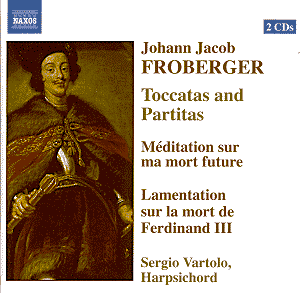Naxos’s Early Keyboard
series is one of their most exciting
ventures, and one of their most scholarly.
Some of the composers have been little
known and the music sometimes rather
slight. Here, however, the series continues
with a real master of the genre who
should be much better known, but who
may not make many converts with this
double CD. Not that there is anything
wrong with the performances, the recordings
or the booklet notes. It is more a case
that these pieces need a very sympathetic
and understanding listener.
The first important
factor is the commitment and sensitivity
of the performer; the second, the instruments;
the third, the editions being used.
Even if you are sceptical
about biographical notes, the fact is
that Sergio Vartolo has quite a discography
and a long pedigree in early keyboard
music. His passion and determination
allow this music an airing and he proves
a formidable player. If you want to
hear him in other, earlier, repertoire,
then do find a particularly intriguing
Naxos four disc CD collection of music
by Giovanni Trabaci (Naxos 8.553553-56).
The Trabaci set was recorded in 1997
and there he employs at least five instruments,
choosing according to the style of the
music.
Turning to the instruments
used here, the booklet contains a slightly
naff picture of the keyboards used.
The best view is of the double manual
original 17th Century harpsichord
used for the Partitas, Lament and the
Tombeau de M. Blancheroche. The other
instrument, an 18th Century
Spinet, is shown the other way round
with Vartolo playing it. They sound
fine instruments but if you think that
they are ‘out of tune’ in the many chromatic
passages favoured by Froberger then
you would be ‘right’ as they are tuned
to the ‘mean tone’. Without being too
technical this is a method of tuning
in fifths which gives a purer tone but
where the chromatic notes are an unequal
distance apart. With modern day equal
temperament the octave is divided into
12 equal semitones, so that a chromatic
passage sounds even but the fifths are
not equal. We are told here that the
French two-manual harpsichord is tuned
to A=390 and the Italian one to A=415,
a slightly brighter sound.
Dealing next with the
editions, the excellent CD booklet notes
by Vartolo himself, imply that that
he makes his own editions. In a brief
essay entitled ‘Acknowledgements and
Observations’ he points out the many
difficulties of obtaining copies of
old publications and of manuscript micro-film.
He also notes how unhelpful some organizations
have been. Earlier in the booklet he
observes: "I have drawn on the
main Viennese sources of Froberger’s
work" and later that the "Most
significant corpus of Froberger’s keyboard
works is that of three autograph manuscripts
preserved in Vienna ... and copied in
the composer’s own hand." One assumes
therefore that he has edited these pieces
himself. My own Schirmer edition of
Froberger (Early keyboard Music Volume
1) is so weak on ornamentation that
there were occasions, as I followed
the performances from my score, that
I was not at all sure if it was same
piece, especially in the free-wheeling
passages at the start of each Toccata.
Schirmers, of course, put in dynamics
and I remember playing the D minor Toccata
in a recital as a student on the piano(!)
and being severely marked down for having
the gall to play it in too romantic
a manner. Anyway, emotion is important
in this music but it should be expressed
through a flexibility of tempo and delectable
ornamentation. It would be good to know
where to obtain Vartolo’s editions.
The CDs are planned
in a clever and ordered manner. Both
begin with a Partita. These are really
four movement dance suites. The opening
section is an Allemande performed in
a very free tempo. The second disc’s
Allemande is a lament suiting the mood
"pour passer la mélancolie".
There follow three Toccatas from book
2 and on disc 2 from Book 4. These pieces
fall into three sections: a free opening
with characteristic rising scales and
quick finger-work, then a fugal section
generally in three parts and finally
a lively compound time section in the
style of a gigue.
Next there follows
another suite-like section: an disc
1 a Partita which is a set of eight
variations on a popular German song,
and on disc 2 a Partita which acts as
a kind of purge for melancholy for ‘Maesta
di Ferdinando IV Re de Romani’. Both
discs end with an extended ‘Tombeau’;
a piece in memory of someone often famous.
Monsieur Blancheroche also had a tombeau
written for him by Louis Couperin who
died in 1661 (recorded by Laurence Cummings
on Naxos 8.550922) a tighter work not
performed with such freedom as this
Froberger version.
The music is presented
in a rather cerebral manner, but in
keeping with this serious-minded composer.
To understand Froberger
further one should take into account
his background. He seems to have had
close ties with Frescobaldi (1583-1643)
who was a famed organist as well as
a composer. His music is often austerely
contrapuntal and its introduction across
the Alps into Germany must have been
well received. It was the Venetians,
probably Andrea Gabrieli (c.1580) who
invented the Toccata and much later
J.S. Bach who brought it to its apogee.
Alongside this Italianate form also
found in some of the dances there is
a strict Germanic seriousness of purpose.
So, how to sum up.
If you are already collecting this series
then no further persuasion is necessary.
As I have said, this is fine music but
it is rather specialist. For example,
although I have played some of these
pieces I can’t imagine that I will play
this CD all that often. It might however
be useful for teaching purposes.
The recordings are
exemplary and the whole presentation
is up to the usual Naxos standard.
Gary Higginson







